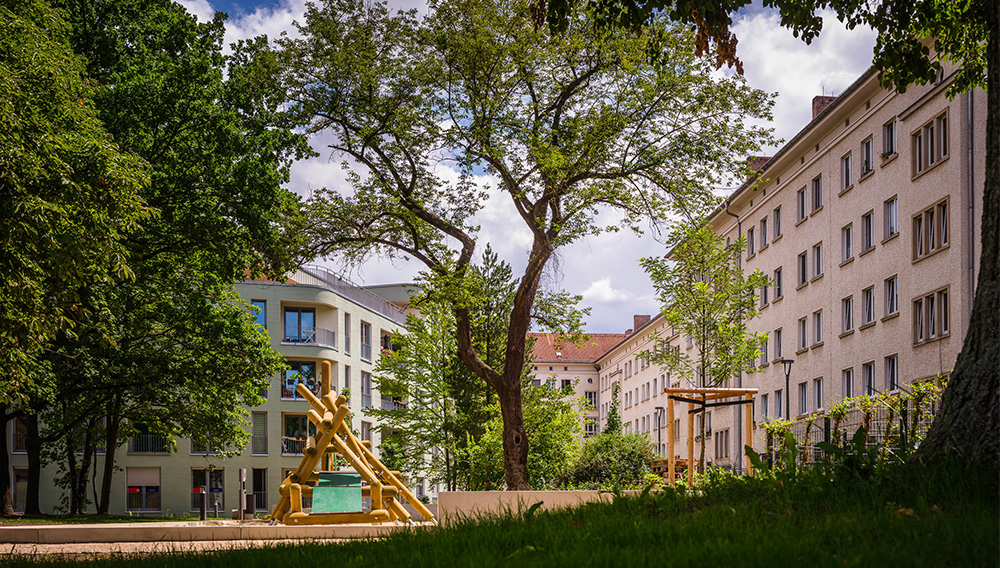Entity-specific Disclosure “Neighborhood Development and Contribution to Infrastructure”
The social megatrends of climate change, urbanization and demographic change determine the framework conditions within which housing providers must develop their services and solutions. Whether it is a greenhouse gas-neutral housing stock, the provision of sufficient affordable housing in large metropolitan areas or services for an aging society – the requirements are wide-ranging and call for integrated solutions.
Thinking and acting in terms of neighborhoods is our answer to these crucial megatrends. It is also the approach we adopt to find solutions for the economic, environmental and social development of our urban housing portfolios, which are largely located in urban quarters. We understand a neighborhood– as per the definition of the Association of German Housing and Real Estate Companies (GdW) – as a visually coherent urban development structure that is seen by its residents as a distinct area and that represents an area for action in which the residential real estate company can make a difference and see positive effects. It comprises at least 150 apartments (see chapter entitled Portfolio in the Property Management Business).
ESRS 2 SBM-3 – Material Impacts, Risks and Opportunities and Their Interaction with Strategy and Business Model
Material Impacts, Risks, and Opportunities
This actual positive impact associated with “increased quality of living for tenants through contribution to neighborhood development and infrastructure” relates to our customers and neighborhoods and, as a result, to our own business and the downstream value chain, which in this case is taken to mean other neighborhood users. It encompasses the effects of neighborhood development that is specifically geared to the needs of stakeholders as well as positive synergy effects resulting from better neighborhood infrastructure. This allows for a reduction in the anticipated costs – for example those associated with making neighborhoods greenhouse gas-neutral – and accelerates the sustainable development of our neighborhoods.
Our neighborhood development activities help us to develop socially and ecologically sustainable places for people to live together in central urban locations and in metropolitan areas, improving our tenants’ quality of living in the process. In the long run, this can result in a more needs-based or environmentally friendly portfolio, better infrastructure connections, greater diversity or a higher level of education/average income in the neighborhood.
The holistic neighborhood approach is mirrored in the company’s strategy and business model: around 77% of Vonovia’s strategic portfolio in Germany is located in around 770 contiguous neighborhoods. Vonovia’s investment and development programs tie in with this portfolio composition – particularly along our strategic climate pathway (see ESRS E1). This makes the holistic neighborhood approach the management level for all ecological, infrastructure-related and social measures. The same also applies to our new construction and development activities. Consequently, this approach has – and indeed will continue to have – a significant influence over the company’s strategic direction. Our neighborhood development measures are a direct result of Vonovia’s business strategy and are consistent with the overarching goal of providing housing that meets the needs of all individuals.
The positive effects of neighborhood development projects can emerge both in the social, structural and direct supply infrastructure within a neighborhood – e.g., by upgrading the housing stock from an ecological perspective, designing new green spaces, creating or supporting communicative neighborhood centers and social and cultural services, strengthening neighborhood networks (e.g., by taking measures to foster integration) or connecting local suppliers and care facilities. Measures like these enhance the quality of life for our tenants and residents in the neighborhood, contributing to a high level of satisfaction, especially among our customers.
The observation period for this impact is limited to a short-term horizon, as it is influenced to a significant degree by the neighborhood-focused investments made in the fiscal year, or planned for the following year. A long-term positive impact can also, however, be expected if several effects related to improved quality of living at neighborhood level are interrelated and reinforce each other in a positive way.
The higher Vonovia’s share of homes in contiguous neighborhoods and the more extensive the measures initiated – e.g., energy-efficient modernization, photovoltaic expansion, upgrading the residential environment – the more direct and impactful the neighborhood infrastructure measures will be. As a result, Vonovia’s share of the positive impact is measured in terms of the scope and direct neighborhood relevance of the investments made and measures implemented in the neighborhoods concerned.
Resilience of Our Business Model
The resilience of Vonovia’s strategy and business model is analyzed and evaluated annually as part of risk management. The risk management time horizon covers the medium term and is supplemented by the planning level to address short-term developments.


